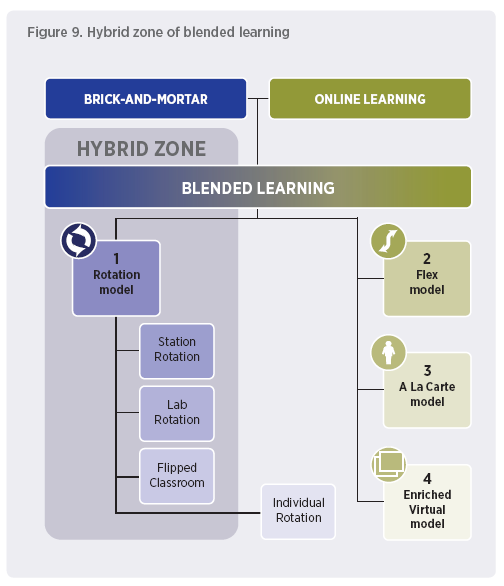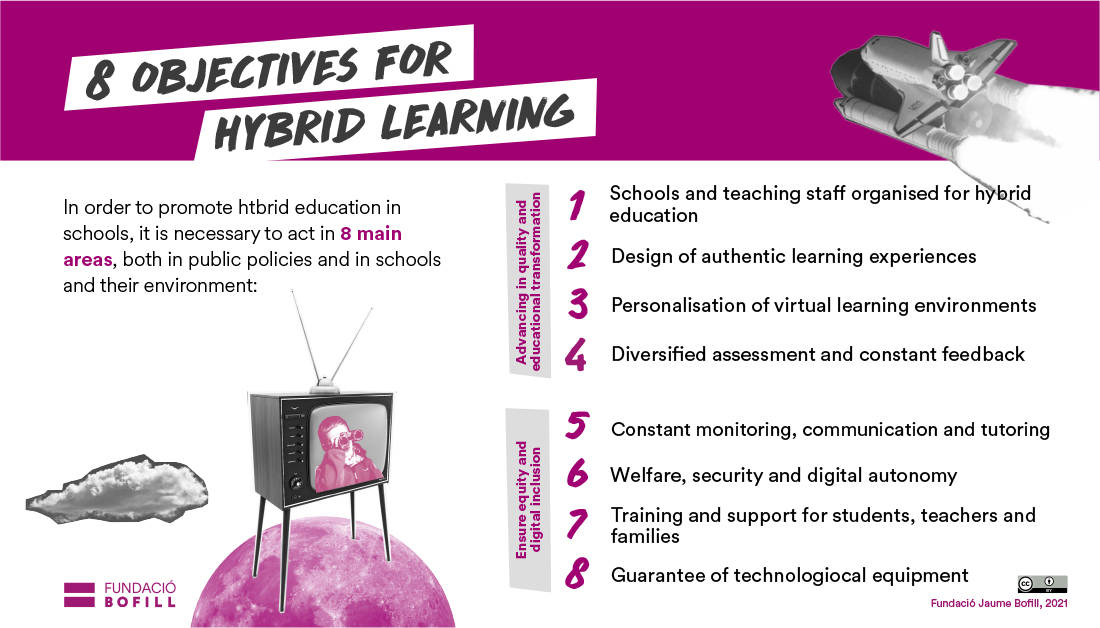The hybrid school, beyond computers and the Internet
19/07/2021

According to the latest UNESCO data, the Covid-19 pandemic has resulted in more than 90% of students in 188 countries being locked down at home without in-person classes. Universities and education and training institutions have conducted classes via digital technologies, or have been trying to do so, meaning that students with or without previous experience in online learning have been immersed in remote classes.
Retrieve the conference How to boost the digital transformation of schools?
Now, various international organisations are stressing the importance of continuing with efforts to build an infrastructure for remote learning and developing the capability of students and teachers to learn and teach in this way. Online education can facilitate the acquisition of essential 21st century learning, as well as skills such as cooperation, communication, independence and development of cognitive abilities.
Related: Read the article Flexibility of space and time, essential requirements for hybrid learning
Life is gradually getting back to normal. Even so, the crisis has exposed the enormous potential for innovation that has remained dormant until now in many education systems. The experience gained over the last two years forms a core foundation for redressing and improving this potential. Accordingly, the reopening of schools should not be understood only as a resumption of the normal functioning of schools. We must avoid “returning to the old normal” and take advantage of all that has been learnt and of all the digital skills acquired over these months, and endeavour creatively to integrate spaces, time, people and technologies into a learning ecosystem (OECD, 2020).
Accordingly, the Catalan Ministry of Education has decided to promote hybrid education and has embarked on a pilot project in a group of schools to identify and promote unique organisational, methodological and relational strategies in schools from a skills-based and inclusive education perspective.
Download the report Hybrid education: How to boost the digital transformation of schools
According to the Catalan Ministry of Education, “hybrid education favours educational transformation of schools through the promotion of their independence and the involvement of the school community and of all the educational agents in the area. It promotes the digital education of students, teachers, families and the local area.”
Opting for a hybrid education model is a lever to transform the education system and accelerate innovation processes which were already taking place in Catalonia and in countries around us
In other words, opting for a hybrid education model and taking advantage of the emergency virtual teaching-learning processes that have been rushed in and, in certain circumstances, improvised due to the pandemic is a lever to transform the education system and accelerate innovation processes which were already taking place in Catalonia and in countries around us.
But, what is a hybrid school?
Hybrid education combines two learning environments. Firstly, there is the traditional environment, which involves face-to-face contact, i.e., in-person classes. Secondly, hybrid education also makes use of a learning environment made possible by digital technologies, with online learning activities.
The various existing models surrounding hybrid learning can be summarised via this following illustration:

The rotation model (with its different variants: laboratory stations, flipped classroom and individual format) allows students to move through different scenarios, moments or learning stations (individual, group and virtual) on a fixed timetable, where at least one of the learning stations is online. This model is more common and frequent in primary schools as teachers have broader control over timescales and orientation at each station within the school building itself or in other community spaces (such as laboratory areas or individual or group study classrooms), where priority is given to more cooperative learning among the students.
One of the most well-known modes of the rotation model is the flipped classroom. This formula breaks with the traditional, more conveyable model, as it transfers the time normally used by teachers to explain theoretical content to the class out of the classroom through the use of videos which reveal the theoretical content.
These videos or digital learning resources can be either selected or created by the teacher and accompanied by an individual work guide which allows students to understand the presented theory. Accordingly, classroom time will be used above all to work on higher-level thinking skills according to the classification proposed in Bloom’s taxonomy for the digital era, such as analysis, assessment and creation via different methodologies in a cooperative learning environment, including support and guidance from the teacher.
Some interesting alternatives to this model that we propose in our document How to boost the digital transformation of schools concern the “out of school” concept, through the use of different areas of the community environment and with related support and guidance. An example of the work dynamics that may unfold in class and out of school can be found effectively summarised in this infographic.
Many higher education institutions have already adopted this method. This is a recent phenomenon that has grown with the advent of digital technologies and, in particular, with access to free online courses such as those offered on platforms including the Kahn Academy, Coursera or Udacity. As an example, the massive open online courses (MOOCS) that some universities are delivering have cast doubt on the need to attend a faculty solely to receive content, as students can access material from home and go to the university in order to resolve questions with the teacher.
The concept of hybrid learning goes beyond the simple use of digital technology and virtual learning environments
Therefore, the concept of hybrid learning goes beyond the simple use of digital technology and virtual learning environments: it involves a reorganisation and redefinition of timeframes and the promotion of student-oriented methodologies. It is a model that integrates both virtual and in-person elements, allowing the best features of each learning environment to be used while maintaining continuity between virtual and in-person formats. Therefore, hybrid classrooms can vary the proportion of different methodologies depending on the subject and the specific requirements of each student group.
Furthermore, students have a certain element of control over the timetable, pace of work and location of the learning process. As the aim of this model is also to promote the independence and socialisation of students as key elements in the personalisation of learning, the school already provides students with spaces and times for individualised support, for independent and personal work, and for cooperative work either online or in a face-to-face group.
For instance, while in primary school both virtual and in-person work is provided within the school during school hours, in secondary schools (especially in the later years) it is possible to begin to use other spaces away from the school premises (libraries, study classrooms, community or cultural facilities, etc.) and promote independence and cooperative work for older students.
The three main strengths of this learning model are that part of the process is carried out online, with a degree of control over the time, place, pathway or pace of students’ learning; secondly, physical space is therefore no longer the focal point, as connectivity can be generated from any location (school and/or community space); and, lastly, along the learning pathway, the in-person and virtual options are connected to provide an integrated learning experience, with continuous support and guidance, without leaving anyone behind.
A hybrid school is a school that conceives learning spaces and times in a very different way, making them extensive and continuous
Therefore, here we propose a hybrid school model with a different approach that redefines and reconceptualises the notion of gathering and physical presence and provides a new way to understand the virtual space and distance. In other words, it is a model that transcends the classic dichotomy between the face-to-face and virtual world. It is a hybrid school model that works by emphasising deeper learning and Fullan’s 6 famous competencies: creativity, communication, collaboration, critical thinking, character and citizenship.

In short, and without fear of error, we could say that a hybrid school is a school that conceives learning spaces and times in a very different way, making them extensive and continuous.
This school model is based, mainly, on five key aspects:
- To open the school up to the local area and the community, using community spaces such as libraries, cultural and community centres.
- To guide and provide continuous support to students by means of the tutoring role in any of the dimensions they are in (face-to-face and/or virtual).
- To prioritise an education model based on the personalisation of learning, where the principles of socialisation, independence and individualised support are key.
- To provide support to schools by mentoring the teachers who work in this format.
- To reduce inequalities and the digital divide among groups and families with more vulnerable children and adolescents.
Therefore, the publication How to boost the digital transformation of schools proposes and specifies a hybrid learning model aimed at ensuring equity and the improvement of learning, in order to develop the digital skills and abilities of all students and to move towards an education model that is more flexible, personalised and student-centred.
Let us recall once again that digital transformation of schools does not merely relate to computers, microchips and cables. It is also about people. It is about knowing and acknowledging the talent of the people who form part of our educational organisations and communities and providing them support and guidance.
Based on the publication Hybrid education. How to boost the digital transformation of schools, at the start of the school year there will be a conference to reflect and share experiences, challenges and knowledge about educational digitalisation with experts, teachers and professors, school principals, technicians and policymakers.
Would you like to find out more?
- Read the article Flexibility of space and time, essential requirements for hybrid learning
- Download the infographic A day in a hybrid school
- See the infographic 8 objectives for hybrid learning
- Download the infographic The 8 pillars of hybrid education
- Download the full report